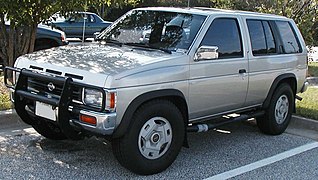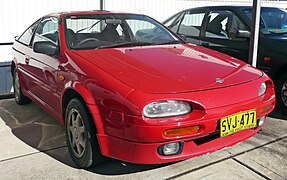Jerry Hirshberg
Gerald Paul Hirshberg | |
|---|---|
| Born | June 30, 1940 San Diego, California |
| Nationality | American |
| Other names | Jerry Paul |
| Occupation(s) | Lead designer, Nissan Design International, 1980–2000 |
| Known for | Automotive and industrial design |
| Website | Official website |
Gerald Paul "Jerry" Hirshberg (June 30, 1940 – November 10, 2019) was an American automotive designer, industrial designer, musician and painter.
Early life and education
Hirshberg studied mechanical engineering at Ohio State University and received a degree with honors in Design from the Cleveland Institute of Art. After graduation, he continued to study in Europe on a Mary C. Page Fellowship. During college, under the stage name Jerry Paul, he released the hit single "Sparkling Blue" in 1959 and opened for well-known musicians such as Bobby Rydell, Fabian, and Frankie Avalon.[2][3] Hirshberg's first automobile was a Volkswagen Beetle.[4]
Automotive design
Hirshberg started his career in automotive design with General Motors in 1964, where he created designs for the Pontiac and Buick divisions under Bill Mitchell,[3] notably the 1971 "boattail" Buick Riviera, where he interpreted Mitchell's original concept.[5] By the time he departed GM, he was the Buick/Pontiac chief designer.[6] Regarding his time at GM, Hirshberg recalled in 1999 that "[the car design trend] was certainly sexual, but it was the sexual fantasies of men. When we lapsed, we were doing design pornography."[7]
In 1980, Hirshberg left GM after being recruited to join
I never wanted to be interviewed later, saying, 'If you had seen what we really wanted to do ... '
— Jerry Hirshberg, 2008 interview with Mark Rechtin[10]
NDI took on several commissions outside automotive design in order to stay creative, including the commercially successful "Bubble Burner" golf club line for nearby TaylorMade,[3] a yacht, and a computer for RDI Computer Corporation.[11]
In 1999, Mickey Kaus attributed Nissan's poor sales performance throughout the 90s to the "loser designs" produced by NDI under Hirshberg.[12] However, earlier in 1999, Hirshberg said Nissan had been directing conservative designs from Japan since the early 90s, after the market failure of the Infiniti J30.[13]
By the late 90s, approximately 75% of Nissan vehicles marketed in the United States were designed at NDI.[10] In 1999, Hirshberg served as the spokesman for Nissan advertising in America.[14] He retired from Nissan at the end of June 2000,[3] turning down a potential promotion to Nissan's global design chief,[1] and continued to pursue artistic interests in retirement.
Credited designs
Hirshberg is credited with creating or assisting with the following designs:
- 1967 Pontiac Firebird[3]
- 1968 Pontiac GTO[3]
- 1971 Buick Riviera[15]
- 1985 Nissan Pathfinder[10][16]
- 1985 Nissan Hardbody pickup[11]
- 1987 Nissan Pulsar NX[2][16]
- 1990 Nissan Gobi (concept)[16][17][18]
- 1991 Nissan NX[11]
- 1992 Infiniti J30[3][16]
- 1992 Nissan Altima[11][16]
- 1992 Nissan Quest[11][2]
- 1999 Nissan Xterra[10]
- 1999 Nissan 240Z Concept[19]
- 2000 Nissan Maxima[20]
- 2000 Nissan Sentra[21]
- 2004 Nissan Maxima[citation needed]
-
1986 Nissan Pathfinder
-
1991 Nissan NX
-
1999 Nissan 240Z Concept
Death
On November 10, 2019, Hirshberg died at his home at the age of 79 after a year-long battle with glioblastoma, a type of brain cancer.[10][22]
References
- ^ a b Rechtin, Mark (March 20, 2000). "Nissan's Hirshberg lays down his pen". Automotive News. Retrieved January 23, 2018.
Jerry Hirshberg, the loquacious and controversial designer who penned some of Nissan's most distinctive vehicles during a 20-year career, will retire as president of the company's Southern California studio June 30. ... His last day as president of Nissan Design International will be his 60th birthday, the same day the Z sports car will be a finished design.
- ^ a b c d "Jerry Hirshberg". HarperCollins. Retrieved November 7, 2016.
- ^ a b c d e f g Patton, Phil (June 30, 2000). "Autos on Friday: Design; A Last Chord From Nissan's Rocker-Designer-Spokesman". The New York Times. Retrieved January 22, 2018.
- ^ Meredith, Robyn (January 4, 1998). "With New Beetle Come Wistful Hints of Old Flame". The New York Times. Retrieved January 24, 2018.
- ^ "History". buick-riviera.com. Retrieved January 23, 2018.
- ISBN 978-1-4602-9690-5. Retrieved January 23, 2018.
- ^ Meredith, Robyn (May 16, 1999). "Ideas & Trends: Hey, Nice Headlights; In Detroit, a Sex Change". The New York Times. Retrieved January 24, 2018.
- ^ Holusha, John (November 14, 1982). "The Americanizing of Japan's Cars". The New York Times. Retrieved January 24, 2018.
- ^ Levin, Doron P. (May 7, 1990). "Motor City in California for Japanese". The New York Times. Retrieved January 24, 2018.
- ^ a b c d e Rechtin, Mark (May 1, 2008). "Jerry Hirshberg". Automotive News. Retrieved January 22, 2018.
- ^ a b c d e Bryant, Adam (May 11, 1992). "Breaking the Mold at Nissan Design". The New York Times. Retrieved January 22, 2018.
- ^ Kaus, Mickey (November 27, 1999). "Who Stole Nissan's Cojones?". Kausfiles. Slate. Retrieved January 23, 2018.
- ^ Passell, Peter (June 6, 1999). "Private Sector; Creating a Comeback at Nissan". The New York Times. Retrieved January 24, 2018.
- ^ Rechtin, Mark (April 12, 1999). "Nissan's chief designer to star in new ads". AdAge. Retrieved January 22, 2018.
- ISBN 978-0-7858-3273-7. Retrieved January 23, 2018.
- ^ a b c d e Patton, Phil (June 30, 2000). "Pages in the Hirshberg Sketchbook". The New York Times. Retrieved January 24, 2018.
- ^ Gromer, Cliff (September 1990). "Dream Haulers". Popular Mechanics. p. 34. Retrieved January 23, 2018.
- ^ Doo, Jack (February 25, 1990). "Nissan hopes concept truck will appeal to women buyers". Santa Cruz Sentinel. Retrieved January 23, 2018.
- ^ "Nissan Z Concept Goes 'Back to Basics'" (Press release). The Auto Channel. January 6, 1999. Retrieved January 23, 2018.
- ^ Dean, Paul (May 13, 1999). "Maxima Gets a Dose of, Well, Viagra". Los Angeles Times. Retrieved March 13, 2024.
But Maxima was too far into its design cycle for the healing hands of the freshly empowered Hirshberg to become really inventive. He did supervise the concept.
- ^ Swan, Tony (May 2000). "Nissan Sentra: Enhanced anonymity". Car and Driver. Retrieved March 13, 2024.
Nissan says that in addition to creating a sense of solidity and substance, a key design objective for the new Sentra was avoiding flashy "look at me" styling. Judging by our initial encounter with the first small car to come from California-based Nissan Design International, we'd say director Jerry Hirshberg's bunch nailed it.
- ^ "Jerry Hirshberg, who opened 1st Nissan design center outside Japan, dies". The Los Angeles Times. November 14, 2019.
External links
- Hirshberg, Jerry (1998). The Creative Priority: Driving Innovative Business in the Real World. New York City: HarperCollins. ISBN 978-0887308307. Retrieved January 22, 2018.
- "Is it the sunshine". Forbes. September 21, 1998. Retrieved January 23, 2018.
- "Fact Sheet: Nissan Design America". Nissan News. 2017. Retrieved January 23, 2018.
- 1999 Nissan Z Concept Car on NAIAS



